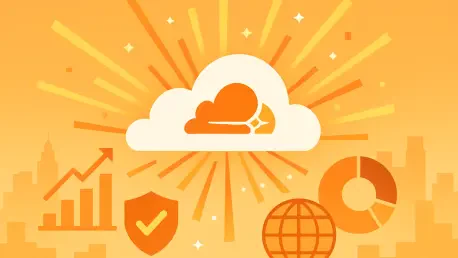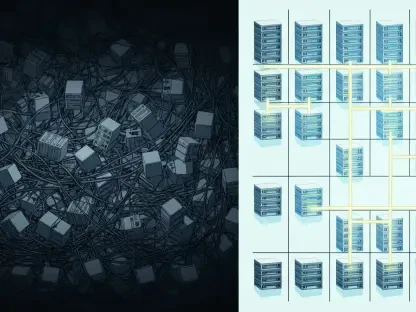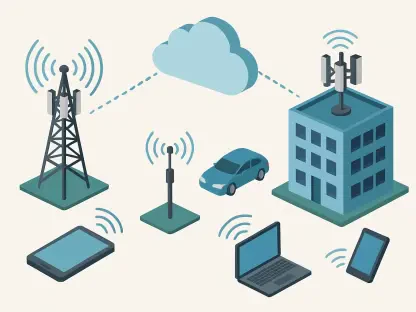In an era where digital reliability underpins global commerce and communication, a major outage can send shockwaves across industries, disrupting operations and trust. On November 18, a significant disruption in Cloudflare’s content delivery network (CDN) halted access to countless websites, affecting platforms like ChatGPT, Canva, and AWS. As a cornerstone of internet infrastructure designed to enhance speed and security, Cloudflare’s failure raised urgent questions about dependency on centralized services. This roundup gathers diverse perspectives from industry experts, analysts, and affected businesses to dissect the impact of this event, explore varying opinions on digital infrastructure risks, and provide actionable insights for navigating such crises.
Unpacking the Crisis: What Happened and Why It Matters
The incident began at 11:48 a.m. UTC when Cloudflare reported an internal service degradation, leading to widespread website inaccessibility with errors like “Internal Server Error (Error Code 500).” Reports from monitoring services noted a sharp increase in user complaints about major platforms, confirming the scale of the disruption. Industry observers highlighted the irony of a service meant to bolster reliability becoming the source of a global breakdown, sparking debates on the vulnerabilities inherent in centralized systems.
Analysts from the tech sector emphasized that this event exposed critical flaws in over-reliance on a single provider for essential online functions. Many pointed out that while Cloudflare plays a pivotal role in speeding up content delivery and protecting against cyber threats, its outage demonstrated how a single point of failure can cascade across the internet. This perspective frames the incident as a wake-up call for companies to reassess their digital strategies and contingency measures.
A contrasting view came from smaller businesses affected by the outage, who expressed frustration over the lack of immediate alternatives. For these entities, the cost of diversifying service providers often outweighs the perceived risk of occasional disruptions. Their feedback underscores a practical challenge: while large corporations may have resources to mitigate such failures, smaller players remain disproportionately vulnerable to systemic hiccups.
Voices from the Field: Diverse Reactions to the Disruption
Immediate Impact: How Websites and Users Responded
Feedback from website operators painted a grim picture of the initial fallout as services ground to a halt. Many reported significant drops in user engagement, with some platforms losing hours of operational capacity during peak times. Business owners shared accounts of customer dissatisfaction, emphasizing that even brief downtimes can erode trust and impact revenue streams.
End users, on the other hand, voiced confusion and irritation over inaccessible services, with social media platforms buzzing with complaints about interrupted workflows. A common sentiment was the lack of clear communication during the early stages of the outage, leaving many unaware of the root cause. This gap in transparency fueled broader discussions about the need for real-time updates during digital crises.
Tech commentators offered a more analytical take, noting that the surge in issues reported on monitoring tools reflected a systemic overload triggered by Cloudflare’s failure. They argued that the incident highlighted a critical dependency on CDN services for maintaining online presence, urging companies to explore redundancy options. This viewpoint stresses that preparation, rather than reaction, holds the key to minimizing damage.
Recovery Challenges: Opinions on the Timeline and Response
Cloudflare’s response timeline, which included temporarily disabling WARP in London and adjusting access protocols, drew mixed reactions from industry watchers. Some praised the company for swift identification of affected services, noting that partial recovery was achieved within hours. However, they cautioned that the prolonged full restoration for application services customers—lasting nearly three hours—revealed gaps in rapid response capabilities.
Business continuity experts expressed concern over the economic ramifications of delayed recovery, particularly for sectors reliant on real-time transactions. Their analysis suggested that extended downtimes could lead to substantial financial losses, pushing for more robust failover mechanisms. This perspective calls attention to the tangible costs of digital interruptions beyond mere inconvenience.
A differing opinion emerged from cybersecurity specialists, who focused on the complexity of managing such a large-scale outage. They argued that the intricate nature of interconnected systems often slows down resolution efforts, as pinpointing and addressing root causes requires meticulous coordination. Their input suggests that patience and understanding of technical limitations are necessary when evaluating provider responses.
Secondary Issues: Support Portal Glitches and Broader Implications
The simultaneous glitch in Cloudflare’s third-party support portal, reported just before the main outage, added another layer of frustration for customers unable to access support channels. Affected users noted that while alternative contact methods were available, the timing of this issue compounded the chaos. This feedback highlights how secondary failures can exacerbate primary disruptions, creating a compounded user experience challenge.
IT consultants weighed in on the broader vulnerabilities exposed by this parallel issue, pointing out that third-party integrations often represent hidden weak points in digital ecosystems. They referenced industry data showing a high incidence of security incidents tied to external providers, advocating for stricter vetting processes. Their stance emphasizes the need to scrutinize every link in the service chain.
Some system architects offered a more nuanced view, suggesting that while third-party risks are real, they are often an unavoidable trade-off for scalability and cost-efficiency. They proposed that instead of eliminating such dependencies, businesses should focus on building layered defenses to mitigate cascading failures. This balanced perspective encourages a pragmatic approach to managing interconnected systems.
Systemic Risks: Debating Third-Party Dependencies
A recurring theme across expert opinions is the systemic fragility introduced by reliance on third-party services. Industry leaders frequently cited statistics, such as a report indicating that 71% of security officers encountered third-party incidents in the past year, to underline the urgency of addressing these risks. Their consensus leans toward proactive risk management as a non-negotiable priority for modern enterprises.
Comparisons to other recent disruptions, like an AWS database glitch earlier this year, were common among analysts who argued that such events are becoming more frequent as digital ecosystems grow in complexity. They warned that without diversified infrastructure, companies remain at the mercy of centralized service providers. This viewpoint pushes for a fundamental shift in how digital dependencies are structured.
On the flip side, some technology advocates suggested that while diversification is ideal, it may not always be feasible due to resource constraints or technical limitations. They recommended starting with smaller, incremental changes, such as regular audits of third-party services, to build resilience over time. This practical advice aims to bridge the gap between ideal solutions and real-world challenges.
Key Takeaways: Lessons from a Global Digital Breakdown
Reflecting on the varied insights, several critical lessons emerged from the Cloudflare incident. Businesses across sectors acknowledged the widespread impact on major platforms and the stark exposure of third-party vulnerabilities. Experts universally agreed that diversifying service providers offers a buffer against such disruptions, though opinions differed on the immediacy and scale of implementation.
Practical tips surfaced from multiple sources, including the importance of monitoring service status updates to stay informed during outages. Building redundancy into digital operations was another widely endorsed strategy, with analysts suggesting that even partial redundancy can significantly reduce downtime risks. These actionable recommendations provide a starting point for companies looking to fortify their online presence.
A final insight came from risk management professionals, who stressed the value of comprehensive contingency planning. They advised prioritizing third-party risk assessments as part of routine operations, ensuring that potential weak links are identified before they fail. This forward-thinking approach aims to transform reactive responses into preventive measures.
Final Reflections and Next Steps
Looking back, the Cloudflare outage served as a stark reminder of the interconnected nature of digital infrastructure, with diverse stakeholders—from businesses to end users—feeling the repercussions of a single provider’s failure. The varied opinions gathered revealed a shared concern over systemic risks while showcasing a spectrum of solutions tailored to different capacities and needs.
Moving forward, companies were encouraged to take concrete steps, such as investing in multi-provider strategies to dilute dependency on any one service. Exploring hybrid models that balance in-house and outsourced solutions emerged as a promising avenue for enhancing resilience. Additionally, staying engaged with industry updates and adopting regular risk audits were highlighted as essential practices to anticipate and mitigate future disruptions. These steps aim to empower organizations to navigate an increasingly complex digital landscape with confidence and preparedness.









